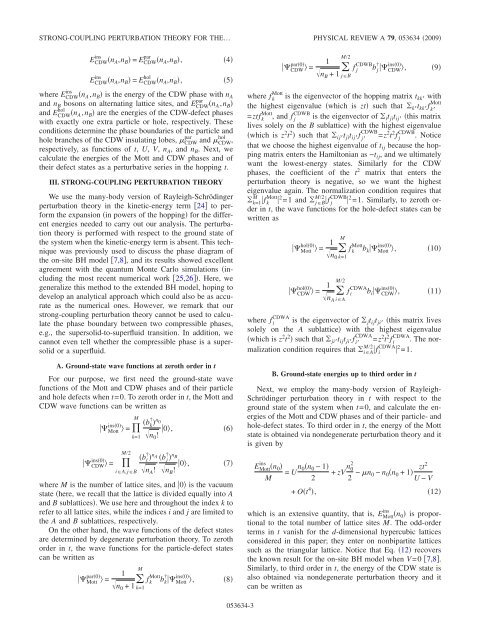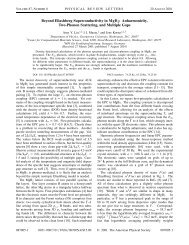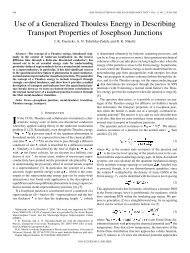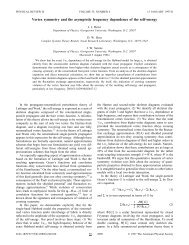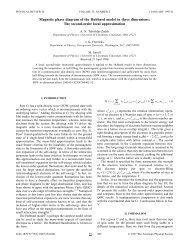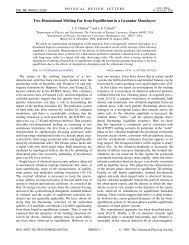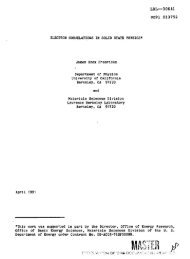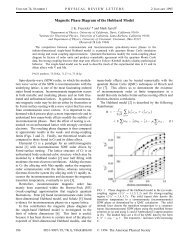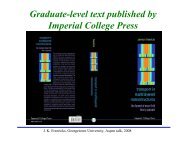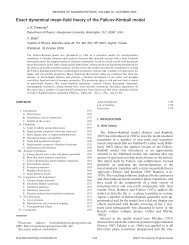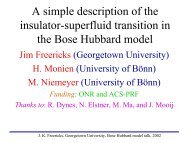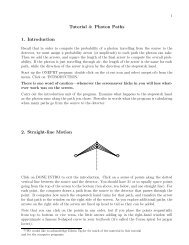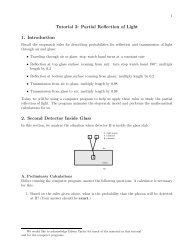Strong-coupling perturbation theory for the extended Bose-Hubbard ...
Strong-coupling perturbation theory for the extended Bose-Hubbard ...
Strong-coupling perturbation theory for the extended Bose-Hubbard ...
Create successful ePaper yourself
Turn your PDF publications into a flip-book with our unique Google optimized e-Paper software.
STRONG-COUPLING PERTURBATION THEORY FOR THE…<br />
PHYSICAL REVIEW A 79, 053634 2009<br />
ins<br />
E CDW<br />
ins<br />
E CDW<br />
par<br />
n A ,n B = E CDW n A ,n B ,<br />
hol<br />
n A ,n B = E CDW n A ,n B ,<br />
ins<br />
where E CDW n A ,n B is <strong>the</strong> energy of <strong>the</strong> CDW phase with n A<br />
par<br />
and n B bosons on alternating lattice sites, and E CDW n A ,n B <br />
hol<br />
and E CDW n A ,n B are <strong>the</strong> energies of <strong>the</strong> CDW-defect phases<br />
with exactly one extra particle or hole, respectively. These<br />
conditions determine <strong>the</strong> phase boundaries of <strong>the</strong> particle and<br />
par hol<br />
hole branches of <strong>the</strong> CDW insulating lobes, CDW and CDW ,<br />
respectively, as functions of t, U, V, n A , and n B . Next, we<br />
calculate <strong>the</strong> energies of <strong>the</strong> Mott and CDW phases and of<br />
<strong>the</strong>ir defect states as a perturbative series in <strong>the</strong> hopping t.<br />
III. STRONG-COUPLING PERTURBATION THEORY<br />
We use <strong>the</strong> many-body version of Rayleigh-Schrödinger<br />
<strong>perturbation</strong> <strong><strong>the</strong>ory</strong> in <strong>the</strong> kinetic-energy term 24 to per<strong>for</strong>m<br />
<strong>the</strong> expansion in powers of <strong>the</strong> hopping <strong>for</strong> <strong>the</strong> different<br />
energies needed to carry out our analysis. The <strong>perturbation</strong><br />
<strong><strong>the</strong>ory</strong> is per<strong>for</strong>med with respect to <strong>the</strong> ground state of<br />
<strong>the</strong> system when <strong>the</strong> kinetic-energy term is absent. This technique<br />
was previously used to discuss <strong>the</strong> phase diagram of<br />
<strong>the</strong> on-site BH model 7,8, and its results showed excellent<br />
agreement with <strong>the</strong> quantum Monte Carlo simulations including<br />
<strong>the</strong> most recent numerical work 25,26. Here, we<br />
generalize this method to <strong>the</strong> <strong>extended</strong> BH model, hoping to<br />
develop an analytical approach which could also be as accurate<br />
as <strong>the</strong> numerical ones. However, we remark that our<br />
strong-<strong>coupling</strong> <strong>perturbation</strong> <strong><strong>the</strong>ory</strong> cannot be used to calculate<br />
<strong>the</strong> phase boundary between two compressible phases,<br />
e.g., <strong>the</strong> supersolid-to-superfluid transition. In addition, we<br />
cannot even tell whe<strong>the</strong>r <strong>the</strong> compressible phase is a supersolid<br />
or a superfluid.<br />
A. Ground-state wave functions at zeroth order in t<br />
For our purpose, we first need <strong>the</strong> ground-state wave<br />
functions of <strong>the</strong> Mott and CDW phases and of <strong>the</strong>ir particle<br />
and hole defects when t=0. To zeroth order in t, <strong>the</strong> Mott and<br />
CDW wave functions can be written as<br />
M ins0 bk<br />
= <br />
† n 0<br />
n0 ! 0,<br />
Mott<br />
ins0 CDW =<br />
k=1<br />
M/2<br />
<br />
iA,jB<br />
b † i n A b † j n B<br />
nA ! nB ! 0,<br />
where M is <strong>the</strong> number of lattice sites, and 0 is <strong>the</strong> vacuum<br />
state here, we recall that <strong>the</strong> lattice is divided equally into A<br />
and B sublattices. We use here and throughout <strong>the</strong> index k to<br />
refer to all lattice sites, while <strong>the</strong> indices i and j are limited to<br />
<strong>the</strong> A and B sublattices, respectively.<br />
On <strong>the</strong> o<strong>the</strong>r hand, <strong>the</strong> wave functions of <strong>the</strong> defect states<br />
are determined by degenerate <strong>perturbation</strong> <strong><strong>the</strong>ory</strong>. To zeroth<br />
order in t, <strong>the</strong> wave functions <strong>for</strong> <strong>the</strong> particle-defect states<br />
can be written as<br />
par0 Mott =<br />
1<br />
M<br />
f Mott k b † k ins0 Mott ,<br />
n0 +1k=1<br />
4<br />
5<br />
6<br />
7<br />
8<br />
par0 CDW =<br />
M/2<br />
1<br />
f CDWB j b † j ins0 CDW ,<br />
nB +1jB<br />
where f Mott k is <strong>the</strong> eigenvector of <strong>the</strong> hopping matrix t kk with<br />
Mott<br />
<strong>the</strong> highest eigenvalue which is zt such that k t kk f k<br />
=ztf Mott k , and f CDWB j is <strong>the</strong> eigenvector of i t ji t ij this matrix<br />
lives solely on <strong>the</strong> B sublattice with <strong>the</strong> highest eigenvalue<br />
which is z 2 t 2 such that ij t ji t ij f CDWB j =z 2 t 2 f CDWB j . Notice<br />
that we choose <strong>the</strong> highest eigenvalue of t ij because <strong>the</strong> hopping<br />
matrix enters <strong>the</strong> Hamiltonian as −t ij , and we ultimately<br />
want <strong>the</strong> lowest-energy states. Similarly <strong>for</strong> <strong>the</strong> CDW<br />
phases, <strong>the</strong> coefficient of <strong>the</strong> t 2 matrix that enters <strong>the</strong><br />
<strong>perturbation</strong> <strong><strong>the</strong>ory</strong> is negative, so we want <strong>the</strong> highest<br />
eigenvalue again. The normalization condition requires that<br />
M k=1 f Mott k 2 =1 and M/2 jB f CDWB j 2 =1. Similarly, to zeroth order<br />
in t, <strong>the</strong> wave functions <strong>for</strong> <strong>the</strong> hole-defect states can be<br />
written as<br />
hol0 Mott = 1<br />
hol0 CDW = 1<br />
M<br />
n0<br />
<br />
k=1<br />
M/2<br />
nA<br />
<br />
iA<br />
f Mott k b k ins0 Mott ,<br />
f CDWA i b i ins0 CDW ,<br />
9<br />
10<br />
11<br />
where f CDWA i is <strong>the</strong> eigenvector of j t ij t ji this matrix lives<br />
solely on <strong>the</strong> A sublattice with <strong>the</strong> highest eigenvalue<br />
which is z 2 t 2 such that ji t ij t ji f CDWA i =z 2 t 2 f CDWA i . The normalization<br />
condition requires that M/2 iA f CDWA i 2 =1.<br />
B. Ground-state energies up to third order in t<br />
Next, we employ <strong>the</strong> many-body version of Rayleigh-<br />
Schrödinger <strong>perturbation</strong> <strong><strong>the</strong>ory</strong> in t with respect to <strong>the</strong><br />
ground state of <strong>the</strong> system when t=0, and calculate <strong>the</strong> energies<br />
of <strong>the</strong> Mott and CDW phases and of <strong>the</strong>ir particle- and<br />
hole-defect states. To third order in t, <strong>the</strong> energy of <strong>the</strong> Mott<br />
state is obtained via nondegenerate <strong>perturbation</strong> <strong><strong>the</strong>ory</strong> and it<br />
is given by<br />
E ins<br />
Mott n 0 <br />
= U n 0n 0 −1<br />
+ zV n 0 2<br />
M<br />
2 2 − n zt 2<br />
0 − n 0 n 0 +1<br />
U − V<br />
+ Ot 4 , 12<br />
which is an extensive quantity, that is, E ins<br />
Mott n 0 is proportional<br />
to <strong>the</strong> total number of lattice sites M. The odd-order<br />
terms in t vanish <strong>for</strong> <strong>the</strong> d-dimensional hypercubic lattices<br />
considered in this paper; <strong>the</strong>y enter on nonbipartite lattices<br />
such as <strong>the</strong> triangular lattice. Notice that Eq. 12 recovers<br />
<strong>the</strong> known result <strong>for</strong> <strong>the</strong> on-site BH model when V=0 7,8.<br />
Similarly, to third order in t, <strong>the</strong> energy of <strong>the</strong> CDW state is<br />
also obtained via nondegenerate <strong>perturbation</strong> <strong><strong>the</strong>ory</strong> and it<br />
can be written as<br />
053634-3


